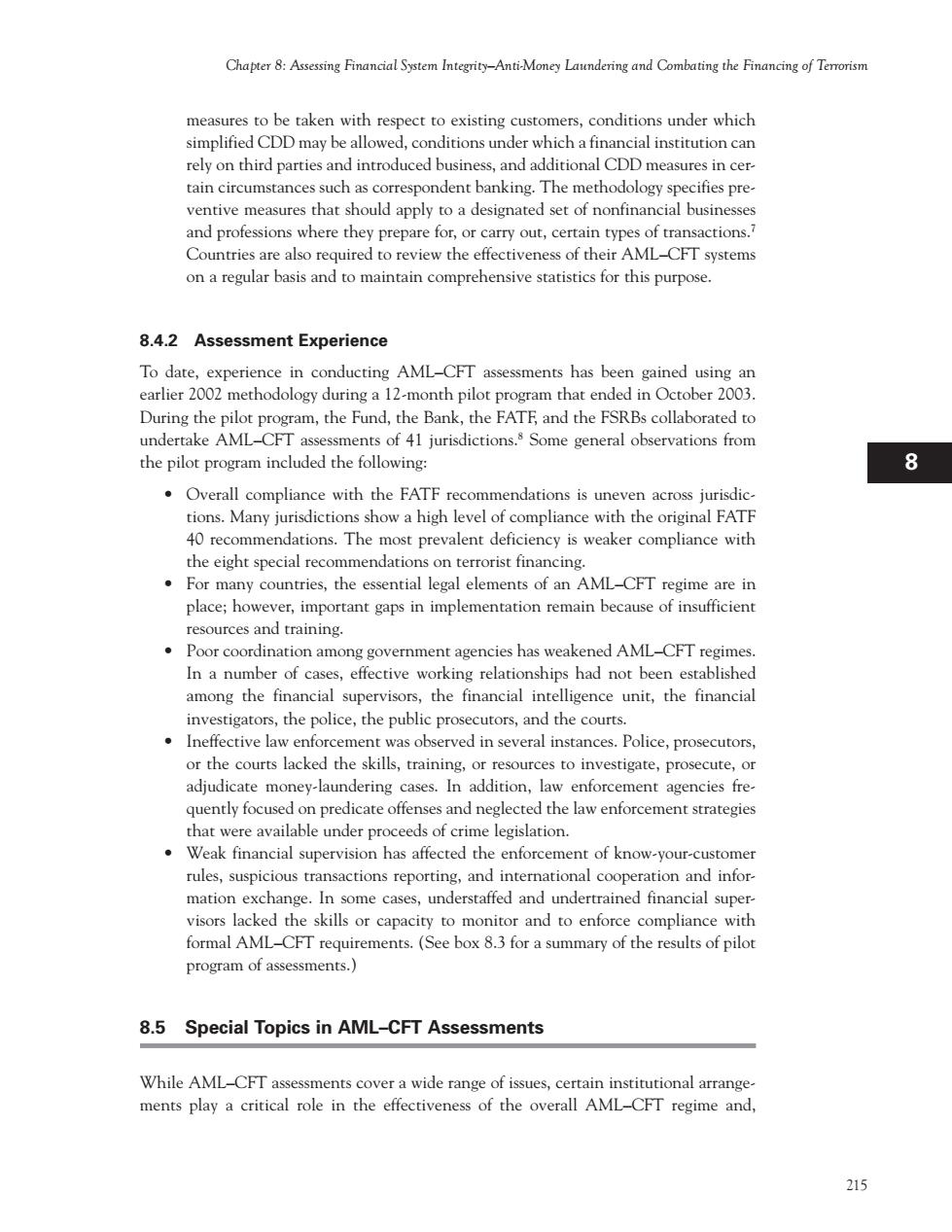正在加载图片...

Chapter8:Assessing Financial System Integrity-Anti-Money Laundering and Combating the Financing of Tenorism measures to be taken with respect to existing customers,conditions under which simplified CDD may be allowed,conditions under which a financial institution can rely on third parties and introduced business,and additional CDD measures in cer tain circumstances such as correspondent banking.The methodology specifies pre ventive measures that should apply to a designated set of nonfinancial businesse and professions where they prepa re for.or c y out,certain types of transactions. als required t view the effe of their AML-CFT system on a regular basis and to maintain comprehensive statistics for this purpose. 8.4.2 Assessment Experience To date,experience in conducting AML-CFT assessments has been gained using an earlier 2002 methodology during a 12-month pilot program that ended in October 2003 During the pilot program,the Fund,the Bank,the FATE and the FSRBs collaborated to undertake AML-CFT assessments of 41 jurisdictions.Some general observations from the pilot program included the following: 8 .Overall compliance with the FATF rec iurisdie Many endations is ur tions show a high level of compliance with theorig inal FATF 40 recommendations.The most prevalent deficiency is weaker compliance with the eight special recommendations on terrorist financing. For many countries.the essential legal elements of an aml-cet regime are in place;however,important gaps in implementation remain because of insufficient resources and training. ·Poor coordination ncies ha eakened aml-ceT regime In a number of case effective wo ing relationships had not been among the financia financia investigators,the police,the public prosecutors,and the courts Ineffective law enforcement was observed in several instances.Police.prosecutors or the courts lacked the skills,training,or resources to investigate,prosecute,or adjudicate money-laundering cases.In addition,law enforcement gencies fre quently focused on predicate offe es and negl d the law enf cement strategie that were available under proceed e legislation Weak financial supervision has affected the enforcement of know-your-customer rules,suspicious transactions reporting,and international cooperation and infor mation exchange.In some cases,understaffed and undertrained financial super visors lacked the skills or capacity to monitor and to enforce compliance with formal aml-CFT requirements.(See box 8.3 for a summary of the results of pilot program of asses sme 8.5 Special Topics in AML-CFT Assessments While AML-CFT ments cover a wide range of issues,certain institutional arrange ments play a critical role in the effectiveness of the overall AML-CFT regime and 215215 Chapter 8: Assessing Financial System Integrity—Anti-Money Laundering and Combating the Financing of Terrorism 1 I H G F E D C B A 12 11 10 9 8 7 6 5 4 3 2 measures to be taken with respect to existing customers, conditions under which simplified CDD may be allowed, conditions under which a financial institution can rely on third parties and introduced business, and additional CDD measures in certain circumstances such as correspondent banking. The methodology specifies preventive measures that should apply to a designated set of nonfinancial businesses and professions where they prepare for, or carry out, certain types of transactions.7 Countries are also required to review the effectiveness of their AML–CFT systems on a regular basis and to maintain comprehensive statistics for this purpose. 8.4.2 Assessment Experience To date, experience in conducting AML–CFT assessments has been gained using an earlier 2002 methodology during a 12-month pilot program that ended in October 2003. During the pilot program, the Fund, the Bank, the FATF, and the FSRBs collaborated to undertake AML–CFT assessments of 41 jurisdictions.8 Some general observations from the pilot program included the following: • Overall compliance with the FATF recommendations is uneven across jurisdictions. Many jurisdictions show a high level of compliance with the original FATF 40 recommendations. The most prevalent deficiency is weaker compliance with the eight special recommendations on terrorist financing. • For many countries, the essential legal elements of an AML–CFT regime are in place; however, important gaps in implementation remain because of insufficient resources and training. • Poor coordination among government agencies has weakened AML–CFT regimes. In a number of cases, effective working relationships had not been established among the financial supervisors, the financial intelligence unit, the financial investigators, the police, the public prosecutors, and the courts. • Ineffective law enforcement was observed in several instances. Police, prosecutors, or the courts lacked the skills, training, or resources to investigate, prosecute, or adjudicate money-laundering cases. In addition, law enforcement agencies frequently focused on predicate offenses and neglected the law enforcement strategies that were available under proceeds of crime legislation. • Weak financial supervision has affected the enforcement of know-your-customer rules, suspicious transactions reporting, and international cooperation and information exchange. In some cases, understaffed and undertrained financial supervisors lacked the skills or capacity to monitor and to enforce compliance with formal AML–CFT requirements. (See box 8.3 for a summary of the results of pilot program of assessments.) 8.5 Special Topics in AML–CFT Assessments While AML–CFT assessments cover a wide range of issues, certain institutional arrangements play a critical role in the effectiveness of the overall AML–CFT regime and